Mos Eisley by Way of Mojave
In the past decade, there has been a flurry of interest in privately funded spaceflight. The most impressive example is the success of SpaceX, founded in 2002 by entrepreneur Elon Musk. But underneath the shadow of SpaceX’s rockets – which are funded by way of over $1 billion in NASA contracts – exists a whole ecosystem of smaller efforts. The epicenter of this activity is the spaceport in the small town of Mojave, California. It’s often referred to as the “Silicon Valley” of the Space 2.0 or NewSpace movement, a comparison I’ll come back to later.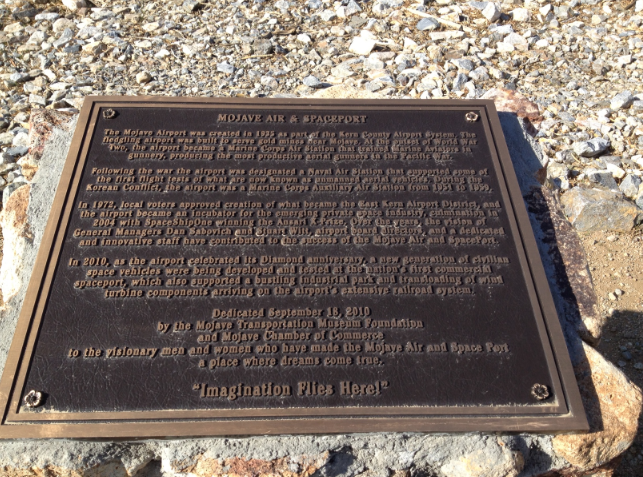 A few weeks ago, I had the chance to visit the Mojave for a tour of its Air and Space Port. This trip was associated with an art exhibit in Riverside called Free Enterprise: The Art of Citizen Space Exploration. Tyler Stallings (UC-Riverside) and Marko Peljhan (UC-Santa Barbara) curated the show which featured and international collection of some 25 artists. (One of favorites is Agnes Meyer-Brandis’s wonderfully fun “Moon Goose Experiment” which I saw last year when I was in Berlin.)
A few weeks ago, I had the chance to visit the Mojave for a tour of its Air and Space Port. This trip was associated with an art exhibit in Riverside called Free Enterprise: The Art of Citizen Space Exploration. Tyler Stallings (UC-Riverside) and Marko Peljhan (UC-Santa Barbara) curated the show which featured and international collection of some 25 artists. (One of favorites is Agnes Meyer-Brandis’s wonderfully fun “Moon Goose Experiment” which I saw last year when I was in Berlin.)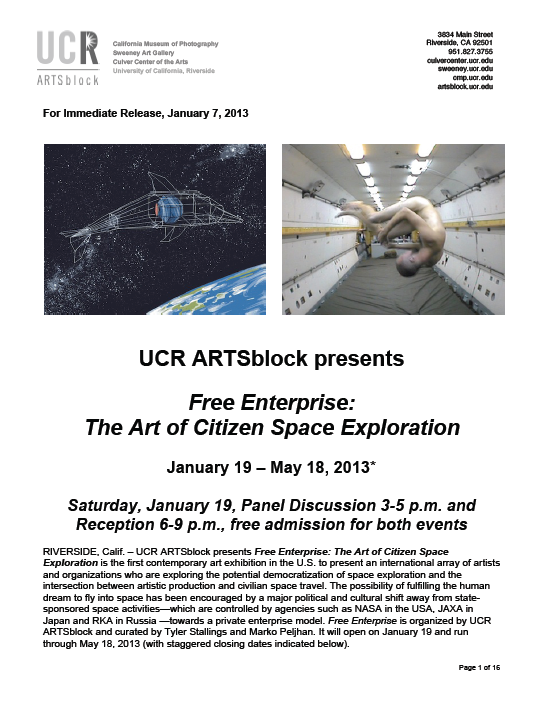 The Mojave Air and Space Port is adjacent to the small Mojave airport which was built in 1935 to service the regions’ gold mining industry. During World War two, a Marine Corps Air Station was located there. The military thread is woven deep into the region with Edwards AFB just a short drive away. The town has a libertarian vibe which causes one some cognitive dissonance given the area’s heavy reliance on federal money. There is also an undercurrent of evangelical Christianity in the town which can be seen in the various signs for churches, ministries, et al..
The Mojave Air and Space Port is adjacent to the small Mojave airport which was built in 1935 to service the regions’ gold mining industry. During World War two, a Marine Corps Air Station was located there. The military thread is woven deep into the region with Edwards AFB just a short drive away. The town has a libertarian vibe which causes one some cognitive dissonance given the area’s heavy reliance on federal money. There is also an undercurrent of evangelical Christianity in the town which can be seen in the various signs for churches, ministries, et al.. When we arrived in Mojave, a dry west wind was already starting to pick up. By afternoon, it was blowing steady 25+ mph. So, we started the tour in the shelter provided by the Roton Atmospheric Test Vehicle, a “single stage to orbit” experimental vehicle built in the late 1990s by Rotary Rocket. Although the improbably designed Roton never flew higher than 75 feet, it was the first major NewSpace project at Mojave and it helped catalyze the nascent industry. It’s an odd looking craft visible from a few miles away which helped provide a landmark for people like me trying to find the spaceport. As one person on the tour said, the Roton offered “a good example of when engineering automatically becomes art.”
When we arrived in Mojave, a dry west wind was already starting to pick up. By afternoon, it was blowing steady 25+ mph. So, we started the tour in the shelter provided by the Roton Atmospheric Test Vehicle, a “single stage to orbit” experimental vehicle built in the late 1990s by Rotary Rocket. Although the improbably designed Roton never flew higher than 75 feet, it was the first major NewSpace project at Mojave and it helped catalyze the nascent industry. It’s an odd looking craft visible from a few miles away which helped provide a landmark for people like me trying to find the spaceport. As one person on the tour said, the Roton offered “a good example of when engineering automatically becomes art.”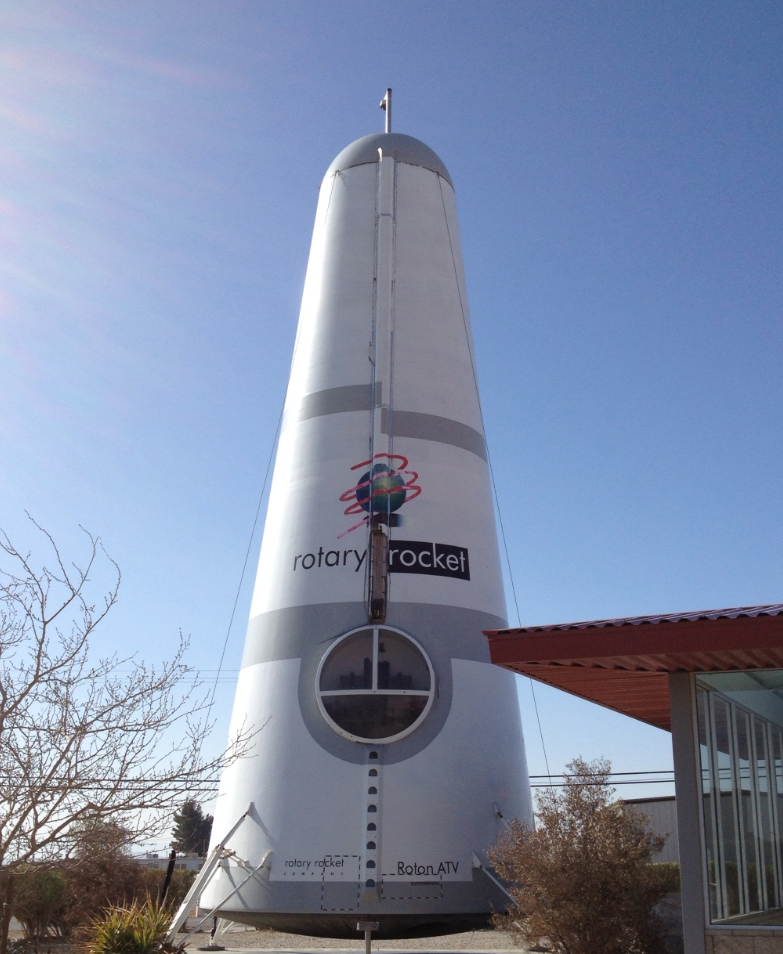 Next to the Roton is a small building that houses a scale model of the Voyager, a super efficient aircraft that flew around the world non-stop in 1986. It hangs above a replica of SpaceShipOne, a smallish craft that completed the first manned private spaceflight in June 2004. First piloted by Michael Melvill, SpaceShipOne flew two more times in 2004 to win the Ansari X-Prize and a $10 million purse ((The last flight was piloted by Brian Binnie; I learned this fact on the tour which caused me some grief as I thought Melvill, as described in The Visioneers, piloted all three trips. I’ll fix this error when the next edition comes out.)) Both the Voyager and SpaceShipOne were designed by Burt Rutan and his company, Scaled Composites, built them. (Former Microsoft tycoon Paul Allen backed the SpaceShipOne venture with $25 million in funding.) Both craft now hang in the National Air and Space Museum’s main gallery.Our next stop was a show of NewSpace photos taken by Mike Massee. Massee presented a photographic chronology of space-related activities at Mojave over the last decade or so. He focused his photoshow largely on the work done by XCOR Aerospace which Massee has worked for since 2001. XCOR was started in 1999 as a spin-off from Rotary Rocket. Its main focus now is building the Lynx, a sub-orbital rocketplane which, when operational, can carry a pilot and passenger some 62+ miles to the edge of space. ((XCOR moved its headquarters and major R&D to Midland, Texas in 2012 in response to some cushy tax breaks from Gov. Rick Perry.))
Next to the Roton is a small building that houses a scale model of the Voyager, a super efficient aircraft that flew around the world non-stop in 1986. It hangs above a replica of SpaceShipOne, a smallish craft that completed the first manned private spaceflight in June 2004. First piloted by Michael Melvill, SpaceShipOne flew two more times in 2004 to win the Ansari X-Prize and a $10 million purse ((The last flight was piloted by Brian Binnie; I learned this fact on the tour which caused me some grief as I thought Melvill, as described in The Visioneers, piloted all three trips. I’ll fix this error when the next edition comes out.)) Both the Voyager and SpaceShipOne were designed by Burt Rutan and his company, Scaled Composites, built them. (Former Microsoft tycoon Paul Allen backed the SpaceShipOne venture with $25 million in funding.) Both craft now hang in the National Air and Space Museum’s main gallery.Our next stop was a show of NewSpace photos taken by Mike Massee. Massee presented a photographic chronology of space-related activities at Mojave over the last decade or so. He focused his photoshow largely on the work done by XCOR Aerospace which Massee has worked for since 2001. XCOR was started in 1999 as a spin-off from Rotary Rocket. Its main focus now is building the Lynx, a sub-orbital rocketplane which, when operational, can carry a pilot and passenger some 62+ miles to the edge of space. ((XCOR moved its headquarters and major R&D to Midland, Texas in 2012 in response to some cushy tax breaks from Gov. Rick Perry.))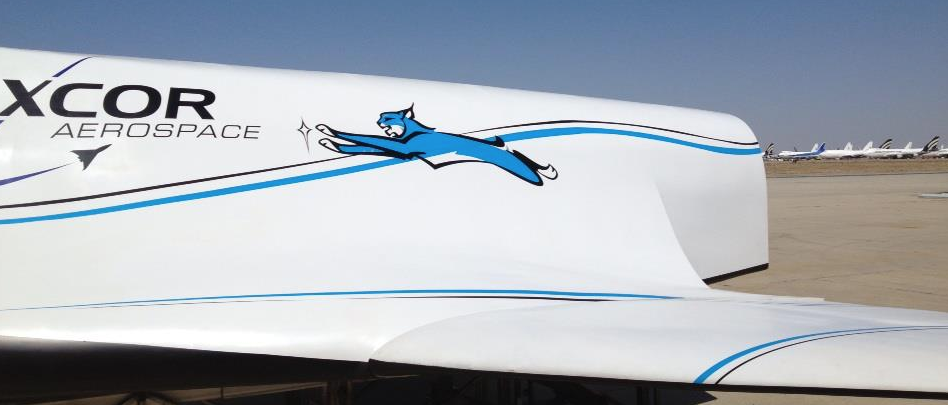 From Massee’s talk, I learned some of the insider lingo at Mojave: engineers are called “rocket plumbers” while an explosion is called a “hard start.” (This can be deadly serious. An explosion in 2007 killed three Scaled Composite employees.)) There was a lot of engineer-speak throughout the talk – Massee was particularly proud of his photos showing the “shock diamonds” produced by XCOR’s rocket engines which have grown in size and power over the past several years. (Lynx will have four engines that each produce 2500 pounds of thrust). The plan is that sometime in the future, flights of the Lynx will take off regularly from a spaceport like Mojave. According to XCOR, some 175 flights have been sold at $95,000 each.What does it take for the FAA to certify your venue as a spaceport anyway? A 1984 law mandates that U.S. citizens obtain a license prior to conducting a launch. Another law passed 30 years later, established a regulatory framework for commercial human space flight. This law also established an “informed consent” protocol for carrying space flight passengers and created a new experimental launch permit for test and development of reusable suborbital launch vehicles. (( According to the FAA, the rules “require launch vehicle operators to provide safety-related information to passengers and to identify what rules an operator must follow in order to conduct a licensed launch with human passengers. All space flight passengers must be fully advised, in writing, of the risks associated with human space flight and they must agree to accept those risks. The protocols also include training and general security requirements for space flight participants.”)) Currently, there are eight FAA-certified spaceports in the U.S.. They’re not like Mos Eisley in terms of flight activity although the airport restaurant in Mojave certainly had a fair share of oddball characters gathered for Saturday lunch.
From Massee’s talk, I learned some of the insider lingo at Mojave: engineers are called “rocket plumbers” while an explosion is called a “hard start.” (This can be deadly serious. An explosion in 2007 killed three Scaled Composite employees.)) There was a lot of engineer-speak throughout the talk – Massee was particularly proud of his photos showing the “shock diamonds” produced by XCOR’s rocket engines which have grown in size and power over the past several years. (Lynx will have four engines that each produce 2500 pounds of thrust). The plan is that sometime in the future, flights of the Lynx will take off regularly from a spaceport like Mojave. According to XCOR, some 175 flights have been sold at $95,000 each.What does it take for the FAA to certify your venue as a spaceport anyway? A 1984 law mandates that U.S. citizens obtain a license prior to conducting a launch. Another law passed 30 years later, established a regulatory framework for commercial human space flight. This law also established an “informed consent” protocol for carrying space flight passengers and created a new experimental launch permit for test and development of reusable suborbital launch vehicles. (( According to the FAA, the rules “require launch vehicle operators to provide safety-related information to passengers and to identify what rules an operator must follow in order to conduct a licensed launch with human passengers. All space flight passengers must be fully advised, in writing, of the risks associated with human space flight and they must agree to accept those risks. The protocols also include training and general security requirements for space flight participants.”)) Currently, there are eight FAA-certified spaceports in the U.S.. They’re not like Mos Eisley in terms of flight activity although the airport restaurant in Mojave certainly had a fair share of oddball characters gathered for Saturday lunch.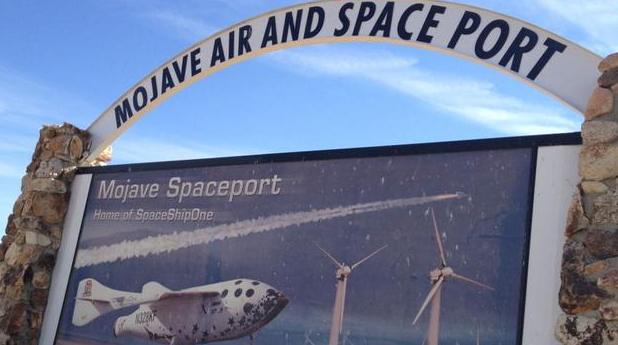 Our last stop was a tour of the XCOR shop at Mojave. The highlight of this was seeing a test of a (very) small rocket engine. Even with just a one-second burn, it produced a deafening sound that made me glad for the ear plugs XCOR staff provided and sent out a wall of heat that reminded me of when I used to visit steel mills in Pittsburgh. Different rocket fuels produce different colors; this one blasted out a jet of blue flame. Nearby the XCOR facility was a local “maker space” akin to a club house where off-duty engineers and technicians were building their own computer numerical controlled machine tool.
Our last stop was a tour of the XCOR shop at Mojave. The highlight of this was seeing a test of a (very) small rocket engine. Even with just a one-second burn, it produced a deafening sound that made me glad for the ear plugs XCOR staff provided and sent out a wall of heat that reminded me of when I used to visit steel mills in Pittsburgh. Different rocket fuels produce different colors; this one blasted out a jet of blue flame. Nearby the XCOR facility was a local “maker space” akin to a club house where off-duty engineers and technicians were building their own computer numerical controlled machine tool.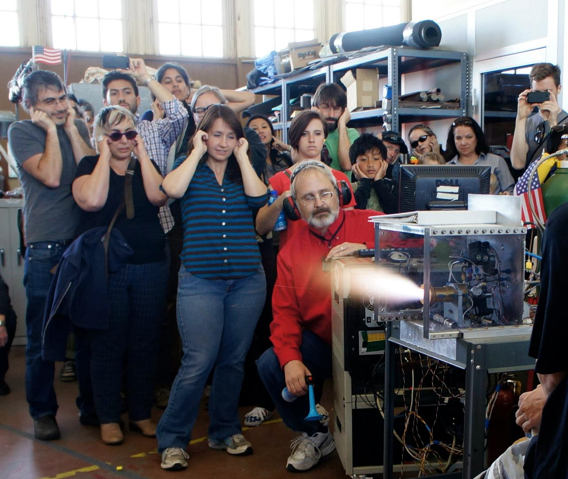 I took away two main impression of the NewSpace effort and the technological ecosystem that has grown up around it. One is that the people engaged in it are not that interested in their history. This is not to say that they don’t care about history – they regularly refer to earlier tests, successful flights, and even some basic historical analogies – opening the frontier, etc.. But they are determinedly focused on the future. A quick conversation with XCOR’s chief test engineer, Doug Jones, made this clear. Jones was well aware of Gerard O'Neill’s space colony ideas and had also been a fan of Eric Drexler’s radical ideas for nanotechnology. He could speak fondly and knowledgeably about both The High Frontier and Engines of Creation. But he didn’t seem interested in framing his own career and his current work in the context of this earlier visioneering. A corollary to this means that NewSpace actors, speaking generally, are not engaged in saving the raw materials that future historians will be able to use to document their work.The second point has to do with how we might think about the NewSpace enterprise as a whole. It’s become fairly common to try and draw some analogies between Mojave and Silicon Valley, for example. ((I recently published an essay that explores this further called “From L5 to X Prize.”)). In some important ways, the attitudes of the NewSpace community resembles another California business culture, that of Silicon Valley. This is not surprising – several major players in the private space business first made their fortunes in computer and internet based businesses. In addition to Microsoft co-founder Paul Allen, Elon Musk (co-founder of PayPal) and Jeff Bezos (founder of Amazon.com) started private space firms. In 2002, for instance, Musk launched SpaceX, a California-based company which hopes to make regular trips to outer space with its series of Falcon rockets. The NewSpace movement, therefore, straddles the classic California divide between NorCal (Silicon Valley) and SoCal (the aerospace industry).The business connections NewSpace entrepreneurs made over the years allowed them to tap into an established network of venture capitalists and “angel investors.” These networks are reflected in other ways as well. Elon Musk, CEO of a NewSpace company called SpaceX, and Larry Page, one of Google’s co-founders, sit on the board of directors for the X-Prize Foundation. The extensive media attention that SpaceShipOne received also helped facilitate fund-raising, acting as a “Matthew Effect” for private space exploration. Since the success of SpaceShipOne, various observers of NewSpace have drawn attention to the Mojave region as the locus of a new entrepreneurial spirit and concomitant business opportunities. One could arguably make the case that Michael Melvill’s brief flights over the California desert constituted a “Netscape moment” for the private space industry.But it would be disingenuous to claim that the isolated town of Mojave, marooned in rural California, is anywhere close to an industrial, financial, and academic “city of knowledge” like Silicon Valley with its universities, government labs, and multi-billion dollar companies. Although Mojave has no multinational firms nor major universities, the region exhibits some of the basic conditions necessary for promoting a space-friendly high-tech region. This includes available land for building, restricted airspace for testing, good flying weather, isolation which maximizes secrecy as well as safety as well as established technology-oriented entities like Edwards Air Force Base and the China Lake Naval Weapons Center. Perhaps, more importantly, is the history of both Silicon Valley and the Antelope Valley where narratives of previous eras and founding figures is conducive to mythmaking. Just as Silicon Valley’s “creation story” rests on the accomplishments of heroic inventors (Hewlett and Packard, Moore and Noyce, Brin and Page), the deserts of southern California have been a similar place of birth, experiment, and regeneration for the aerospace industry.
I took away two main impression of the NewSpace effort and the technological ecosystem that has grown up around it. One is that the people engaged in it are not that interested in their history. This is not to say that they don’t care about history – they regularly refer to earlier tests, successful flights, and even some basic historical analogies – opening the frontier, etc.. But they are determinedly focused on the future. A quick conversation with XCOR’s chief test engineer, Doug Jones, made this clear. Jones was well aware of Gerard O'Neill’s space colony ideas and had also been a fan of Eric Drexler’s radical ideas for nanotechnology. He could speak fondly and knowledgeably about both The High Frontier and Engines of Creation. But he didn’t seem interested in framing his own career and his current work in the context of this earlier visioneering. A corollary to this means that NewSpace actors, speaking generally, are not engaged in saving the raw materials that future historians will be able to use to document their work.The second point has to do with how we might think about the NewSpace enterprise as a whole. It’s become fairly common to try and draw some analogies between Mojave and Silicon Valley, for example. ((I recently published an essay that explores this further called “From L5 to X Prize.”)). In some important ways, the attitudes of the NewSpace community resembles another California business culture, that of Silicon Valley. This is not surprising – several major players in the private space business first made their fortunes in computer and internet based businesses. In addition to Microsoft co-founder Paul Allen, Elon Musk (co-founder of PayPal) and Jeff Bezos (founder of Amazon.com) started private space firms. In 2002, for instance, Musk launched SpaceX, a California-based company which hopes to make regular trips to outer space with its series of Falcon rockets. The NewSpace movement, therefore, straddles the classic California divide between NorCal (Silicon Valley) and SoCal (the aerospace industry).The business connections NewSpace entrepreneurs made over the years allowed them to tap into an established network of venture capitalists and “angel investors.” These networks are reflected in other ways as well. Elon Musk, CEO of a NewSpace company called SpaceX, and Larry Page, one of Google’s co-founders, sit on the board of directors for the X-Prize Foundation. The extensive media attention that SpaceShipOne received also helped facilitate fund-raising, acting as a “Matthew Effect” for private space exploration. Since the success of SpaceShipOne, various observers of NewSpace have drawn attention to the Mojave region as the locus of a new entrepreneurial spirit and concomitant business opportunities. One could arguably make the case that Michael Melvill’s brief flights over the California desert constituted a “Netscape moment” for the private space industry.But it would be disingenuous to claim that the isolated town of Mojave, marooned in rural California, is anywhere close to an industrial, financial, and academic “city of knowledge” like Silicon Valley with its universities, government labs, and multi-billion dollar companies. Although Mojave has no multinational firms nor major universities, the region exhibits some of the basic conditions necessary for promoting a space-friendly high-tech region. This includes available land for building, restricted airspace for testing, good flying weather, isolation which maximizes secrecy as well as safety as well as established technology-oriented entities like Edwards Air Force Base and the China Lake Naval Weapons Center. Perhaps, more importantly, is the history of both Silicon Valley and the Antelope Valley where narratives of previous eras and founding figures is conducive to mythmaking. Just as Silicon Valley’s “creation story” rests on the accomplishments of heroic inventors (Hewlett and Packard, Moore and Noyce, Brin and Page), the deserts of southern California have been a similar place of birth, experiment, and regeneration for the aerospace industry.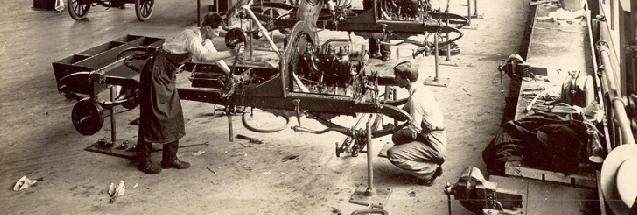 In the end, I am inclined to not see contemporary Silicon Valley as the best analog to understanding Mojave as it exists today. Instead, as I walked around the town and peeked in the various work spaces, I was reminded of something much older. I thought of the small Midwestern shops where people like Ransom Olds, James Packard, and the Stanley Brothers experimented with early automobile designs on the cusp of the Gilded Age. This comparison seem most apropos to understanding the Mojave scene. Some of these efforts succeeded; others flopped. For every SpaceShipOne, there is a Roton. But the smell of oil and feel of fine metallic grit pervaded both the small-scale shops of the late 19th century as well as those clustered around today’s embryonic spaceports.Perhaps this parallel shouldn't surprise us. The early automobilists and the rocket engineers at Mojave today are both geared toward creating a new form of transportation. It took years, if not decades, before the automobile became more than an unreliable toy for the wealthy. How long will it take for companies at Mojave to rocket us into the future?
In the end, I am inclined to not see contemporary Silicon Valley as the best analog to understanding Mojave as it exists today. Instead, as I walked around the town and peeked in the various work spaces, I was reminded of something much older. I thought of the small Midwestern shops where people like Ransom Olds, James Packard, and the Stanley Brothers experimented with early automobile designs on the cusp of the Gilded Age. This comparison seem most apropos to understanding the Mojave scene. Some of these efforts succeeded; others flopped. For every SpaceShipOne, there is a Roton. But the smell of oil and feel of fine metallic grit pervaded both the small-scale shops of the late 19th century as well as those clustered around today’s embryonic spaceports.Perhaps this parallel shouldn't surprise us. The early automobilists and the rocket engineers at Mojave today are both geared toward creating a new form of transportation. It took years, if not decades, before the automobile became more than an unreliable toy for the wealthy. How long will it take for companies at Mojave to rocket us into the future?